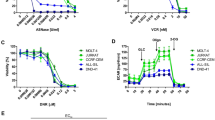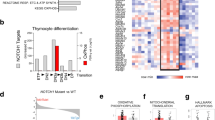Abstract
The altered metabolism of cancer cells is a treasure trove to discover new antitumoral strategies. The gene (SLC7A5) encoding system L amino-acid transporter 1 (LAT1) is overexpressed in murine lymphoma cells generated via T-cell deletion of the pten tumor suppressor, and also in human T-cell acute lymphoblastic leukemia (T-ALL)/lymphoma (T-LL) cells. We show here that a potent and LAT1 selective inhibitor (JPH203) decreased leukemic cell viability and proliferation, and induced transient autophagy followed by apoptosis. JPH203 could also alter the in vivo growth of luciferase-expressing-tPTEN−/− cells xenografted into nude mice. In contrast, JPH203 was nontoxic to normal murine thymocytes and human peripheral blood lymphocytes. JPH203 interfered with constitutive activation of mTORC1 and Akt, decreased expression of c-myc and triggered an unfolded protein response mediated by the C/EBP homologous protein (CHOP) transcription factor associated with cell death. A JPH203-resistant tPTEN−/−clone appeared CHOP induction deficient. We also demonstrate that targeting LAT1 may be an efficient broad spectrum adjuvant approach to treat deadly T-cell malignancies as the molecule synergized with rapamycin, dexamethasone, doxorubicin, velcade and l-asparaginase to alter leukemic cell viability.
This is a preview of subscription content, access via your institution
Access options
Subscribe to this journal
Receive 12 print issues and online access
$259.00 per year
only $21.58 per issue
Buy this article
- Purchase on Springer Link
- Instant access to full article PDF
Prices may be subject to local taxes which are calculated during checkout








Similar content being viewed by others
References
Aifantis I, Raetz E, Buonamici S . Molecular pathogenesis of T-cell leukaemia and lymphoma. Nat Rev Immunol 2008; 8: 380–390.
Pui CH, Relling MV, Downing JR . Acute lymphoblastic leukemia. N Engl J Med 2004; 350: 1535–1548.
Cheson BD . Novel therapies for peripheral T-cell non-Hodgkin's lymphomas. Curr Opin Hematol 2009; 16: 299–305.
Hanahan D, Weinberg RA . Hallmarks of cancer: the next generation. Cell 2011; 144: 646–674.
Levine AJ, Puzio-Kuter AM . The control of the metabolic switch in cancers by oncogenes and tumor suppressor genes. Science 2010; 330: 1340–1344.
Zhao WL . Targeted therapy in T-cell malignancies: dysregulation of the cellular signaling pathways. Leukemia 2010; 24: 13–21.
Salmena L, Carracedo A, Pandolfi PP . Tenets of PTEN tumor suppression. Cell 2008; 133: 403–414.
Hagenbeek TJ, Spits H . T-cell lymphomas in T-cell-specific Pten-deficient mice originate in the thymus. Leukemia 2008; 22: 608–619.
Yanagida O, Kanai Y, Chairoungdua A, Kim D, Segawa H, Nii T et al. Human L-type amino acid transporter 1 (LAT1): characterization of function and expression in tumor cell lines. Biochem Biophys Acta 2001; 1514: 291–302.
Kobayashi H, Ishii Y, Takayama T . Expression of L-type amino acid transporter 1 (LAT1) in esophageal carcinoma. J Surg Oncol 2005; 90: 233–238.
Kaira K, Oriuchi N, Otani Y, Shimizu K, Tanaka S, Imai H et al. Fluorine-18-alpha-methyltyrosine positron emission tomography for diagnosis and staging of lung cancer: a clinicopathologic study. Clin Cancer Res 2007; 13: 6369–6378.
Sakata T, Ferdous G, Tsuruta T, Satoh T, Baba S, Muto T et al. L-type amino-acid transporter 1 as a novel biomarker for high-grade malignancy in prostate cancer. Pathol Int 2009; 59: 7–18.
Wempe MF, Rice PJ, Lightner JW, Jutabha P, Hayashi M, Anzai N et al. Metabolism and pharmacokinetic studies of JPH203, an L-amino acid transporter 1 (LAT1) selective compound. Drug Metab Pharmacokinet 2012; 27: 155–161.
Oda K, Hosoda N, Endo H, Saito K, Tsujihara K, Yamamura M et al. L-type amino acid transporter 1 inhibitors inhibit tumor cell growth. Cancer Sci 2010; 101: 173–179.
Uchino H, Kanai Y, Kim DK, Wempe MF, Chairoungdua A, Morimoto E et al. Transport of amino acid-related compounds mediated by L-type amino acid transporter 1 (LAT1): insights into the mechanisms of substrate recognition. Mol Pharmacol 2002; 61: 729–737.
Feral CC, Nishiya N, Fenczik CA, Stuhlmann H, Slepak M, Ginsberg MH . CD98hc (SLC3A2) mediates integrin signaling. Proc Natl Acad Sci USA 2005; 102: 355–360.
Hagenbeek TJ, Naspetti M, Malergue F, Garcon F, Nunes JA, Cleutjens KB et al. The loss of PTEN allows TCR alphabeta lineage thymocytes to bypass IL-7 and Pre-TCR-mediated signaling. J Exp Med 2004; 200: 883–894.
Soulier J, Clappier E, Cayuela JM, Regnault A, Garcia-Peydro M, Dombret H et al. HOXA genes are included in genetic and biologic networks defining human acute T-cell leukemia (T-ALL). Blood 2005; 106: 274–286.
Galluzzi L, Larochette N, Zamzami N, Kroemer G . Mitochondria as therapeutic targets for cancer chemotherapy. Oncogene 2006; 25: 4812–4830.
Puissant A, Robert G, Auberger P . Targeting autophagy to fight hematopoietic malignancies. Cell Cycle 2010; 9: 3470–3478.
Janes MR, Limon JJ, So L, Chen J, Lim RJ, Chavez MA et al. Effective and selective targeting of leukemia cells using a TORC1/2 kinase inhibitor. Nat Med 2010; 16: 205–213.
Nicklin P, Bergman P, Zhang B, Triantafellow E, Wang H, Nyfeler B et al. Bidirectional transport of amino acids regulates mTOR and autophagy. Cell 2009; 136: 521–534.
Suraweera A, Munch C, Hanssum A, Bertolotti A . Failure of amino acid homeostasis causes cell death following proteasome inhibition. Mol Cell 2012; 48: 242–253.
Tabas I, Ron D . Integrating the mechanisms of apoptosis induced by endoplasmic reticulum stress. Nat Cell Biol 2011; 13: 184–190.
Zinszner H, Kuroda M, Wang X, Batchvarova N, Lightfoot RT, Remotti H et al. CHOP is implicated in programmed cell death in response to impaired function of the endoplasmic reticulum. Genes Dev 1998; 12: 982–995.
Boyce M, Bryant KF, Jousse C, Long K, Harding HP, Scheuner D et al. A selective inhibitor of eIF2alpha dephosphorylation protects cells from ER stress. Science 2005; 307: 935–939.
Walter P, Ron D . The unfolded protein response: from stress pathway to homeostatic regulation. Science 2011; 334: 1081–1086.
Oyadomari S, Mori M . Roles of CHOP/GADD153 in endoplasmic reticulum stress. Cell Death Differ 2004; 11: 381–389.
Harding HP, Zhang Y, Zeng H, Novoa I, Lu PD, Calfon M et al. An integrated stress response regulates amino acid metabolism and resistance to oxidative stress. Mol Cell 2003; 11: 619–633.
Ye J, Rawson RB, Komuro R, Chen X, Dave UP, Prywes R et al. ER stress induces cleavage of membrane-bound ATF6 by the same proteases that process SREBPs. Mol Cell 2000; 6: 1355–1364.
Yanagisawa N, Ichinoe M, Mikami T, Nakada N, Hana K, Koizumi W et al. High expression of L-type amino acid transporter 1 (LAT1) predicts poor prognosis in pancreatic ductal adenocarcinomas. J Clin Pathol 2012; 65: 1019–1023.
Nawashiro H, Otani N, Shinomiya N, Fukui S, Ooigawa H, Shima K et al. L-type amino acid transporter 1 as a potential molecular target in human astrocytic tumors. Int J Cancer 2006; 119: 484–492.
Furuya M, Horiguchi J, Nakajima H, Kanai Y, Oyama T . Correlation of L-type amino acid transporter 1 and CD98 expression with triple negative breast cancer prognosis. Cancer Sci 2012; 103: 382–389.
Ichinoe M, Mikami T, Yoshida T, Igawa I, Tsuruta T, Nakada N et al. High expression of L-type amino-acid transporter 1 (LAT1) in gastric carcinomas: comparison with non-cancerous lesions. Pathol Int 2011; 61: 281–289.
Kaira K, Oriuchi N, Imai H, Shimizu K, Yanagitani N, Sunaga N et al. l-type amino acid transporter 1 and CD98 expression in primary and metastatic sites of human neoplasms. Cancer Sci 2008; 99: 2380–2386.
Vandewynckel YP, Laukens D, Geerts A, Bogaerts E, Paridaens A, Verhelst X et al. The paradox of the unfolded protein response in cancer. Anticancer Res 2013; 33: 4683–4694.
Sinclair LV, Rolf J, Emslie E, Shi YB, Taylor PM, Cantrell DA . Control of amino-acid transport by antigen receptors coordinates the metabolic reprogramming essential for T cell differentiation. Nat Immunol 2013; 14: 500–508.
Hayashi K, Jutabha P, Endou H, Sagara H, Anzai N . LAT1 is a critical transporter of essential amino acids for immune reactions in activated human T cells. J Immunol 2013; 191: 4080–4085.
Guo W, Lasky JL, Chang CJ, Mosessian S, Lewis X, Xiao Y et al. Multi-genetic events collaboratively contribute to Pten-null leukaemia stem-cell formation. Nature 2008; 453: 529–533.
Bulus N, Feral C, Pozzi A, Zent R . CD98 increases renal epithelial cell proliferation by activating MAPKs. PLoS One 2012; 7: e40026.
Boulter E, Estrach S, Errante A, Pons C, Cailleteau L, Tissot F et al. CD98hc (SLC3A2) regulation of skin homeostasis wanes with age. J Exp Med 2013; 210: 173–190.
Rosilio C, Lounnas N, Nebout M, Imbert V, Hagenbeek T, Spits H et al. The metabolic perturbators metformin, phenformin and AICAR interfere with the growth and survival of murine PTEN-deficient T cell lymphomas and human T-ALL/T-LL cancer cells. Cancer Lett 2013; 336: 114–126.
Acknowledgements
We are sincerely grateful to Ms Cendrine Dubaud regarding her expertise to maintain the mouse strains and assistance to generate the tPTEN−/− KO mice. We also thank the C3M Imaging Core Facility (Microscopy and Imaging Platform Côte d'Azur) and C3M animal room facility. Furthermore, we express thanks to: Ms Chimène Morillon (Affymetrix analysis assistance); Dr Bernard Mari (transcriptomic result discussions) Dr Chloé Féral for discussion about CD98; Dr Marilyne Poirée, Professor Vahid Asnafi and Ms Amélie Trincand for proving primary T-ALL samples and clinical information; Dr Marie Bénéteau (statistical analysis advice); Rodolphe Pontier-Bress (small animal imaging assistance). The Centre Méditerranéen de Médecine Moléculaire (C3M) provided the financial support to perform the current research. CR is a PhD fellowship recipient via La Ligue Nationale Contre le Cancer and EG is supported by a fellowship from La Fondation de France. The Centre Méditerranéen de Médecine Moléculaire (C3M) provided the financial support to perform the current research. BB-M thanks the Benjamin Delessert Institute, AFEF/Aptalis and SFD/MSD for their support.
Author information
Authors and Affiliations
Corresponding author
Ethics declarations
Competing interests
HE is CEO of J-Pharma Co., Ltd. (Yokohama, Japan) while MFW served as a Scientific Advisory Board Member for J-Pharma from August 2006 to July 2013. J-Pharma has been developing LAT1 inhibitor JPH203 for use regarding cancer therapeutics/diagnostics; consequently, HE and MFW have a financial interest in J-Pharma. The remaining authors declare no conflict of interest.
Additional information
Supplementary Information accompanies this paper on the Leukemia website
Supplementary information
Rights and permissions
About this article
Cite this article
Rosilio, C., Nebout, M., Imbert, V. et al. L-type amino-acid transporter 1 (LAT1): a therapeutic target supporting growth and survival of T-cell lymphoblastic lymphoma/T-cell acute lymphoblastic leukemia. Leukemia 29, 1253–1266 (2015). https://doi.org/10.1038/leu.2014.338
Received:
Revised:
Accepted:
Published:
Issue Date:
DOI: https://doi.org/10.1038/leu.2014.338
This article is cited by
-
Characterization of an iPSC-based barrier model for blood-brain barrier investigations using the SBAD0201 stem cell line
Fluids and Barriers of the CNS (2023)
-
Combination effects of amino acid transporter LAT1 inhibitor nanvuranlat and cytotoxic anticancer drug gemcitabine on pancreatic and biliary tract cancer cells
Cancer Cell International (2023)
-
Targeting Glutamine Metabolism as an Attractive Therapeutic Strategy for Acute Myeloid Leukemia
Current Treatment Options in Oncology (2023)
-
Small molecule inhibitors for cancer metabolism: promising prospects to be explored
Journal of Cancer Research and Clinical Oncology (2023)
-
Phosphoproteomics revealed cellular signals immediately responding to disruption of cancer amino acid homeostasis induced by inhibition of l-type amino acid transporter 1
Cancer & Metabolism (2022)



